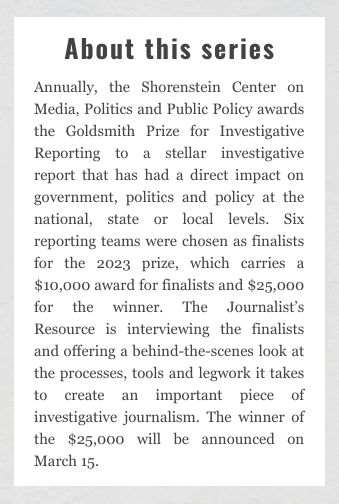The behind-the-scenes workings of the Matrix consulting firm, including payments it made to local news sites to ensure their coverage in Florida and Alabama reflected the priorities of powerful clients, might still be a secret had an anonymous source not leaked hundreds of pages of internal documents last year.
When journalists at Floodlight first reviewed the records, they had a hard time understanding what they showed. The environmental news collaborative teamed up with National Public Radio to investigate. Week by week, journalists from both newsrooms scrutinized and worked to confirm pieces of information they found in Matrix emails, financial ledgers and other documents.
Their five month-long investigation focuses on two Matrix clients — Florida Power & Light and Alabama Power, two of the nation’s largest power companies. Floodlight and NPR published the resulting series, “Power Play,” in December. It reveals how Matrix, its clients and affiliated organizations paid hundreds of thousands of dollars to six news sites and a TV news producer to attack the power companies’ critics.
“This is a story about money and politics and power and the environment and journalism and how [news professionals] bent to the will of these extraordinarily big economic powers in a way that was completely hidden from public view,” says David Folkenflik, who covers the media industry for NPR and was part of the investigative team.

The news sites denied their work had been influenced by the payments, Folkenflik and Floodlight investigative reporters Miranda Green and Mario Ariza reported. They also reported that when they analyzed news stories published by the three Alabama news sites linked to Matrix, they discovered that Alabama Power received “overwhelmingly positive coverage.”
The three Alabama sites are Yellowhammer News, Alabama Today and Alabama Political Reporter. The three Florida news sites that Floodlight and NPR investigated are Florida Politics, Sunshine State News and The Capitolist.
“Coverage of Matrix’s power company clients at the six news sites ebbed and surged around election seasons and other key inflection points,” the investigative team writes. “For example, Sunshine State News emerged when Sen. Rick Scott, a consistent ally of Florida Power & Light, was governor of Florida and maintained warm ties with him. Matrix records show the firm paid the site at least $180,000. It shuttered a year after he won election to the U.S. Senate. A former Scott aide also founded The Capitolist, based in Tallahassee.”
In total, the news sites collected at least $900,000 between 2013 and 2020 from Matrix, its clients and affiliated organizations, some of which were nonprofit groups, according to the series.
Matrix internal documents show the firm had given Kristen Hentschel, a freelance producer at ABC News at the time, at least $14,350 since 2016.
One of the two stories in the series focuses on Hentschel, who, the journalists report, “did not return multiple detailed requests for comment.”
“Interviews for this story and Matrix ledgers show Hentschel traded on her work for ABC News at least three times to trip up Florida politicians whose stances on environmental regulations cut against the interests of major Matrix clients,” Green, Ariza and Folkenflik write.
Not only did the series make big discoveries, it also had a big impact.
Shortly after stories in the series ran on Dec. 19 and Dec. 21, Alabama Power’s chief executive officer, Mark Crosswhite, stepped down, Ariza and Folkenflik reported in January. ABC News cut ties with Hentschel.
In January, Florida Power & Light announced its CEO, Eric Silagy, was retiring early.
The Journalist’s Resource reached out to Green, Ariza and Folkenflik to seek out advice for other journalists wanting to pursue similar projects. They discussed how they reported out the series and shared tips on using and verifying leaked documents, building relationships with sources, and using “distant reading” tools to navigate large sets of documents.
Here are four of those tips.
1. Think of a set of leaked documents as a treasure map. It can point you toward people and places holding key information.
Over the course of the investigation, Green, Ariza and Folkenflik reviewed 1,200-plus pages of leaked internal records, including financial ledgers and email messages, from the Matrix consulting firm. The journalists couldn’t assume any were authentic or unaltered, so they spent months verifying and analyzing the information.
Ariza says the reporting team used the set of documents like a treasure map, which pointed them to people and organizations they could reach out to for help.
“We looked through all the documents and pulled out the stuff that seemed the most interesting and the most understandable to us because a lot of stuff, we didn’t understand,” Ariza says. “As we attempted to verify what was in the documents, we reached out to the people who were named in them.”
Throughout the investigation, Folkenflik says they sought out people with direct or secondary knowledge. They also pored over news stories from various news outlets about the utility companies and Matrix, contacted various government agencies and reviewed public records such as court filings and IRS Form 990s, which are tax forms submitted by nonprofit organizations.
“We tried to look in every nook and cranny we could,” he says.
Individual pieces of the story eventually came together, revealing the power companies’ extensive efforts to shut down their political foes.
2. Don’t report any information you get from leaked documents until you’ve confirmed them with 100% certainty.
When you’re reporting a story that can have major, widespread impacts like this series did, it can be tempting, at times, to share information you strongly believe is true but haven’t yet fully confirmed. Green warns journalists not to give in to that temptation.
“We really went to the ends of the earth and even further to make sure these were trustworthy factoids,” she says.
Ariza points out that in addition to disappointing and misleading audiences, sharing bad information can land a news outlet in court. Even accurate, well-sourced stories can face legal challenges. Several people threatened NPR and Floodlight with legal action, including a former Matrix employee and one of the news site editors named in the series.
“The parties [in this series] are so aggressive and adversarial and so litigious that you want to — first of all, you owe it to the readers to — only put stuff out there that’s bulletproof and that you’re willing to fight to the death on in a court of law.”
3. Use research tools such as Google Pinpoint to navigate lengthy documents.
Ariza recommends reporters use digital research tools to get a broad sense of the information contained is in a document or group of documents without having to read them. The process is referred to as “distant reading.”
“Learn how to do distant reading using Google Pinpoint for large bodies of text,” he says. “It’s your friend.”
Pinpoint, one of several digital tools Google provides in its Journalist Studio, can help reporters spot patterns among words and gauge how often certain people, places and organizations are mentioned. The tool is free for journalists, but they need to register to receive access.
Ariza used Pinpoint to find out which names appear frequently in the leaked records his team received.
“It was really useful in identifying some of the nicknames some of these political operatives would give to, for example, the CEO of a power company,” he says.
4. Talk to everyone you can. Invest time cultivating relationships with key sources.
When you’re trying to understand an issue or problem, interview a wide variety of people. Green, Ariza and Folkenflik spoke with elected leaders, community leaders, officials from multiple government agencies and even journalists working in newsrooms that had been covering the power companies for many years.
They also used social media to track down people with links to Matrix, the two power companies and the six news outlets Matrix had paid.
“We spent hours upon hours every day making calls to people, having informal conversations, building relationships with people who knew what was going on,” Green says. “You have to work with these sources who are out there to help them help you.”
Keep in mind that anyone could have useful information. Even if someone cannot provide information that’s central to your investigation, that person might be able to provide context or recommend other people to interview, Green says.
An example: When the reporting team learned Matrix had made payments to TV news producer Kristen Hentschel, they began asking sources, “What is this name to you?” One source remembered seeing a Facebook post from U.S. Rep. Brian Mast two years earlier complaining about Hentschel showing up unexpectedly at his home in Florida to speak to his wife while he was in Washington.
Hentschel had presented herself as an ABC News reporter, Mast said in the short video he made and posted to Facebook.
“We would never have found that on our own,” Green says. “We reached out to the congressman and asked him if he remembered. He thought she was a Democratic operative. He himself became a bevy of information.”
Folkenflik says it’s important for journalists to remember as they cultivate relationships with sources that it could take several interviews with the same person to nail down key details.
“On these stories, we would go back to a source once, twice, three times, four times — sometimes multiple times for one piece of information,” he says.
Read the stories:
In the Southeast, power company money flows to news sites that attack their critics
She was an ABC News producer. She also was a corporate operative


Expert Commentary